I purchased my first pair of barefoot shoes in 2021, in preparation for an animal-based gathering in Costa Rica. At the time, I had no idea how switching to barefoot shoes would transform my health by significantly improving my posture, reducing my lower back pain, and strengthening foot muscles I didn’t even know I had.
Today, 95% of my footwear is barefoot or minimalist, and my family has followed suit. In this article, I’ll share the best barefoot shoes that I’ve found for various activities, from CrossFit to date night.
After researching and trying dozens of minimalist shoe brands and models over the years, these are my top picks:
- Peluva makes arguably the most fashionable toe shoes on the market. I own half a dozen pairs in different styles, including some I wear on date nights. They feature soles that are thin enough to provide excellent ground contact and feedback while remaining comfortable for all-day use (even on hard surfaces such as asphalt).
- Xero is a great option for people who are new to barefoot shoes because their wide toe box and zero-drop sole encourage natural foot movement, making them a great transition shoe for those just starting out. Plus, the brand offers a wide variety of styles at budget-friendly prices.
- Feelgrounds offers the most comfortable barefoot shoes I’ve tried. Their Move sneakers are lightweight and flexible, and they have a 4 mm sole that offers just enough protection without compromising the barefoot experience.
- Belleville’s Mini-Mil TR105 is a durable, minimalist boot made for rough environments, like hiking and tactical applications. The 2 mm Vibram Tarsus sole provides excellent ground feel, ensuring you’re connected to the terrain without compromising foot protection.
- Vivo Barefoot is pricier than other options on this list, but their quality and durability make the brand’s shoes well worth the investment.
- Origo is our choice for kids’ shoes. They’re handmade by artisans in Mexico using sustainable materials. They’re also reasonably priced – an important factor considering how quickly kids outgrow their shoes (or run them into the ground).
- Lems brand’s Chelsea Boots are one of the best options for those needing a barefoot boot that can handle tough outdoor conditions. Featuring an 11 mm stack height, these boots provide extra foot protection while maintaining a zero-drop sole for natural movement. Note that the Lems don’t have laces (similar to rubber boots) and are meant for tasks like gardening and outdoor chores, not for hiking.
Scroll down for more on why I love each of these brands, including specifically which models my family wears for which use cases.
Peluva

| Styles I own | Best for |
|---|---|
| Strand Trainers | Road running, everyday use and casual workouts. |
| Strand ATR Trainers | CrossFit and other functional or high-intensity workouts. I’d also consider the ATX best for trail running or light hiking. |
| Miami Casual Loafers | Best for everyday use and for around the house (since they’re easy to get into). |
| Napa Dress Hybrid Shoes | Best for the office, date nights or formal events. |
When it comes to the best true barefoot shoes, Peluva easily tops the list for me. They’re the only brand I own with individual toe boxes, and this feature has led to meaningful improvements in the alignment of my toes by allowing them to splay out naturally. If you’ve been wearing traditional shoes for years like I did, you might have experienced some misalignment in your toes, and Peluvas help correct that.
What I really appreciate about Peluvas is their balance between comfort and ground feel. Their 9 mm thick sole might be considered too thick by some barefoot shoe purists, but for me, it strikes the perfect middle ground. Whether I’m walking on hard surfaces like concrete or spending the day behind a booth at a biohacking conference (watch the clip reel below below to see them in action), I love the sensory feedback I get without feeling every sharp rock underfoot.
And, of course, the zero-drop design keeps my posture in check, something that I’ve noticed has made a big difference over time. (I used to suffer from lower back pain if I had to be on my feet on hard surfaces, like when manning a booth at conferences.)
Style-wise, I have to say Peluva’s leather shoes are among the best for date night or even a more formal setting. While my wife is usually not a fan of toe shoes, she actually prefers the look of my Peluvas compared to my old Vibrams. The Napa Dress Hybrid in particular is a great option if you need something for the office or a night out. Plus, they’re flexible enough that I can wear them sockless for ultimate breathability and comfort. If you do go sockless, I recommend stuffing them with an old sock filled with baking soda after each use to reduce odor.
If you’d like to get your pair of Peluva minimalist shoes, make sure to use my affiliate code MICHAEL during checkout for a 10% discount.
Xero
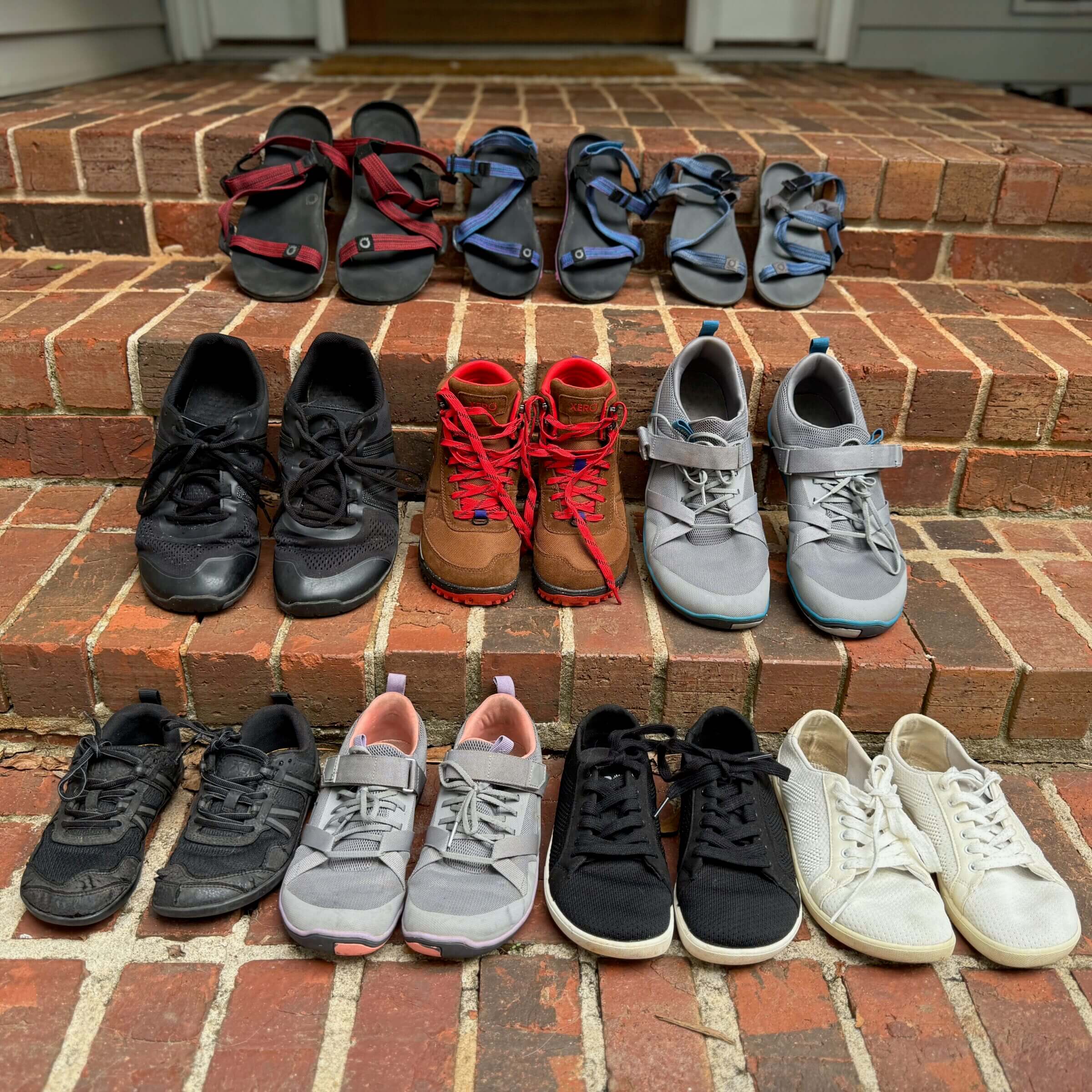
| Styles we own | Best for |
|---|---|
| Z-Trail EV Sandals | Trail hiking. |
| HFS II Sneakers | Road running and everyday use. |
| Dillon Leather Sneakers | Daily use and walking. |
| Prio Running and Fitness Shoes (Kids) | Outdoor play, running and casual exercise. |
| Forza Trainers | Weightlifting and functional fitness (e.g., CrossFit). |
| Ridgeway Hiking Boots | Hiking. |
If you’re looking for a great all-around barefoot shoe that’s budget-friendly, Xero is one of the best overall options. I first came across Xero shoes a few years ago and was immediately impressed by their wide variety of styles. Whether you need something for running, hiking, or just everyday wear, Xero has a model that fits the bill. Their zero-drop soles and wide toe boxes encourage a natural gait and foot positioning, which has been instrumental in improving my overall posture and avoiding lower back pain.
For example, the HFS II is my pick for the best for road running. It’s lightweight and flexible, and the 5.5 mm stack height is perfect for getting good ground feel while still protecting your feet from rough terrain. On the other hand, the Ridgeway is the best for hiking if you need something that provides more foot protection but doesn’t sacrifice that barefoot feel. The wide toe box allows for natural toe splay, which is something I always look for in a good barefoot shoe.
The one downside I’ve noticed is that Xero shoes don’t hold up as well as premium brands like Vivo Barefoot, especially for kids who tend to run their shoes into the ground. However, given the price, Xero is still one of the best overall options if you’re looking for affordability without sacrificing too much in terms of performance. I also like that they’re lightweight and work well sockless or with thin socks, depending on the weather.
Feelgrounds

| Styles we own | Best for |
|---|---|
| Patrol Winter Boots & Patrol Winter Kids Boots | Everyday use in cold, rainy or snowy conditions. |
| Move Sneakers | Everyday use and casual workouts, thanks to the odor-minimizing TENCEL fabric. |
For sheer comfort, Feelgrounds is one of the best overall barefoot shoe brands I’ve come across. Their sneakers feel like socks with soles — lightweight, flexible, and super comfortable. The Move sneakers, which I wear frequently, have a 4 mm sole that offers a great mix of ground feel and foot protection. If you’re looking for something you can wear all day for casual use or workouts, Feelgrounds is hard to beat.
Feelgrounds also offers a range of stack heights, with models like the Patrol winter boots, which have a 10 mm sole, making them the best for hiking or even just keeping your feet warm and dry in colder months. If you prefer wearing your barefoot shoes sockless, you’ll appreciate the TENCEL fabric used in some of Feelgrounds’ sneakers to help reduce odor and to keep your feet cool.
One thing I should point out is that Feelgrounds doesn’t use animal-based materials like leather and instead relies on vegan-friendly materials like faux leather. While I usually prefer natural leather for its durability, Feelgrounds’ synthetic materials are durable, and their shoes hold up well under regular use. They’re a little more fashion-forward, especially since they cater to the European market, but that makes them a great option if you’re looking for something versatile and stylish. If you want the best for casual everyday wear, Feelgrounds is a fantastic choice.
Belleville

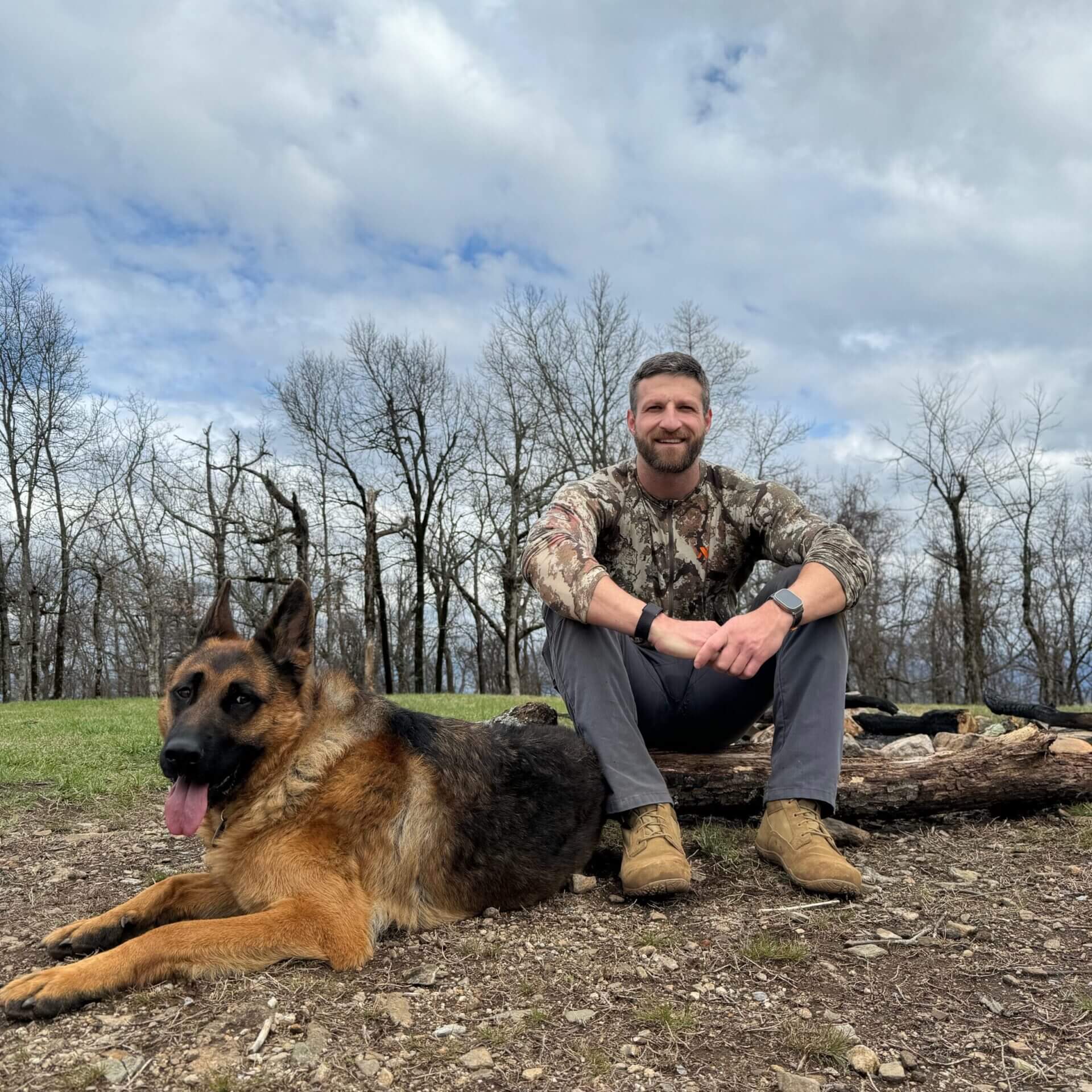
| Styles I own | Best for |
|---|---|
| Mini-Mil TR105 Tactical Boots | Tactical applications, military and law enforcement. |
If you need minimalist boots for rugged activities, Belleville’s Mini-Mil TR105 boots are one of the best for hiking and tactical purposes. I’ve worn these boots for everything from hiking to shooting practice, and they’ve performed really well. With a 2 mm Vibram Tarsus sole, you get excellent ground feel while still maintaining the necessary foot protection you’d expect from a tactical boot.
These boots also feature a zero-drop design, which helps maintain a natural posture. The leather and nylon upper is tough and durable, and the boots dry out quickly if they get wet — something that’s important when you’re out in the elements. For an 8-inch boot, they’re surprisingly lightweight, weighing just a pound each, which makes them comfortable to wear for long periods.
One of the best things about the Mini-Mil TR105 is their compliance with U.S. Army and Air Force uniform standards. So if you’re in law enforcement or the military, these boots may meet your dress requirements. For anyone looking for a minimalist boot that offers durability, flexibility, and great traction, Belleville is one of the best overall for outdoor use.
Vivo Barefoot

| Styles we own | Best for |
|---|---|
| Ababa II Slip-On | Indoor use as a barefoot alternative to traditional slippers or house shoes. |
| Primus Sport III | Barefoot alternative to traditional trainers. Our kids use them for playing tennis and other sports. |
| Primus Ludo Kids | Everyday use, school and running around the yard. |
| Primus Asana III Sneakers | Casual workouts and walking. |
| Pilgrim Grounding Boots | Grounding and walks in nature and on natural surfaces. |
Vivo Barefoot is, without a doubt, one of the best overall barefoot shoe brands. Yes, they’re more expensive than other options, but the quality you get is unmatched. The 2.5 mm soles on most of their shoes give you incredible ground feel, which is exactly what you want in a true barefoot shoe. When I’m walking on gravel or uneven terrain, I can feel everything beneath my feet, which helps me stay more connected to the ground.
For outdoor adventures, the Pilgrim grounding boots are one of my favorites and are hands-down the best for hiking if you’re looking for a barefoot experience in nature. These boots feature a conductive sole that helps keep you grounded while you’re out in natural environments. And while Vivo shoes have thin soles, they still provide enough foot protection to handle rougher terrains.
One of the biggest reasons I love Vivo Barefoot is their focus on sustainability. They use eco-friendly materials and durable craftsmanship, so while the shoes come with a higher price tag, they’re built to last. In my opinion, if you’re serious about barefoot shoes, Vivo is the best overall choice for long-term value. Plus, the breathable design makes them perfect for sockless wear, so you can feel the benefits of barefoot living without any unnecessary bulk.
If you’d like to get your pair of Vivo Barefoot shoes, make sure to use my affiliate code MKUMMER20 during checkout for a 20% discount.
Origo
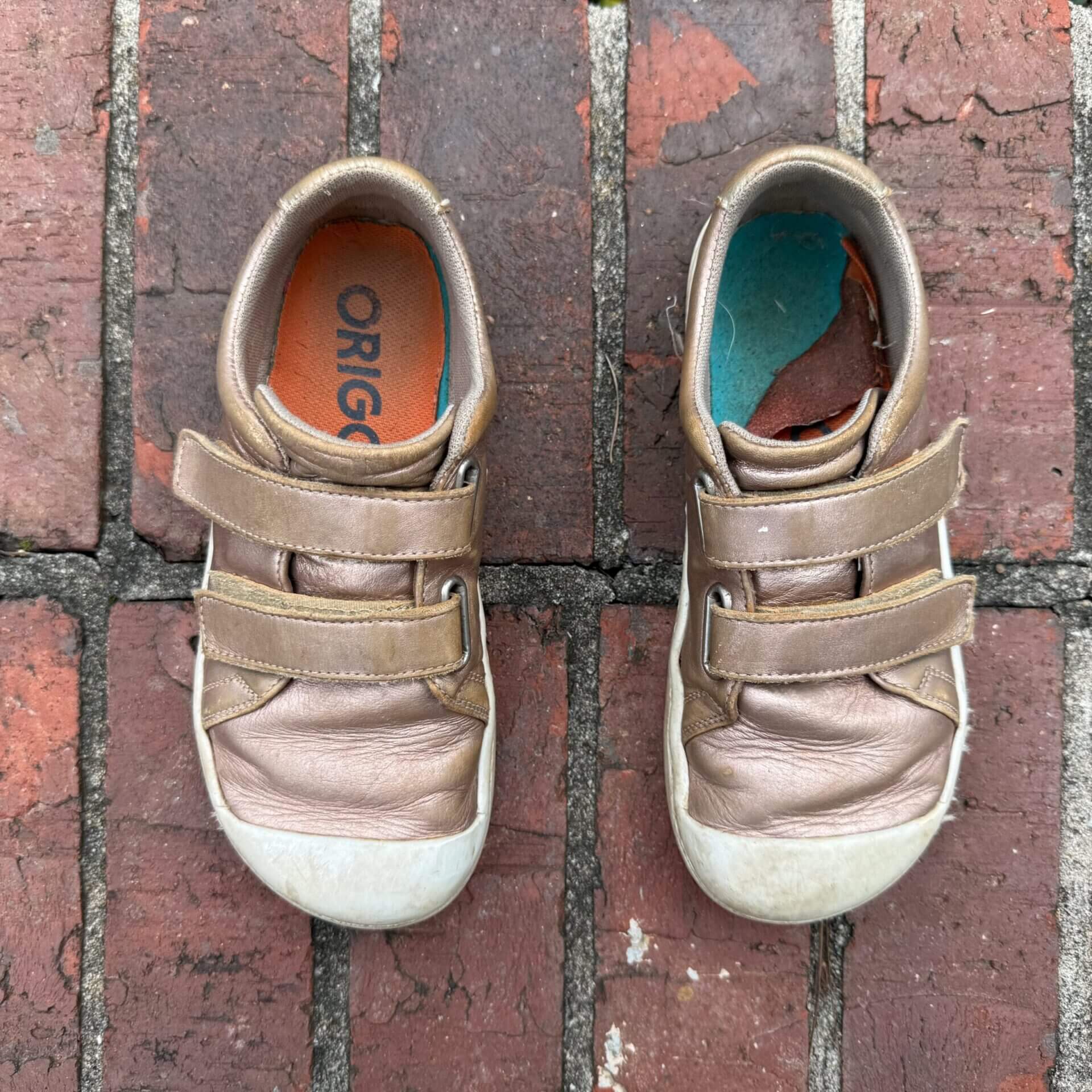
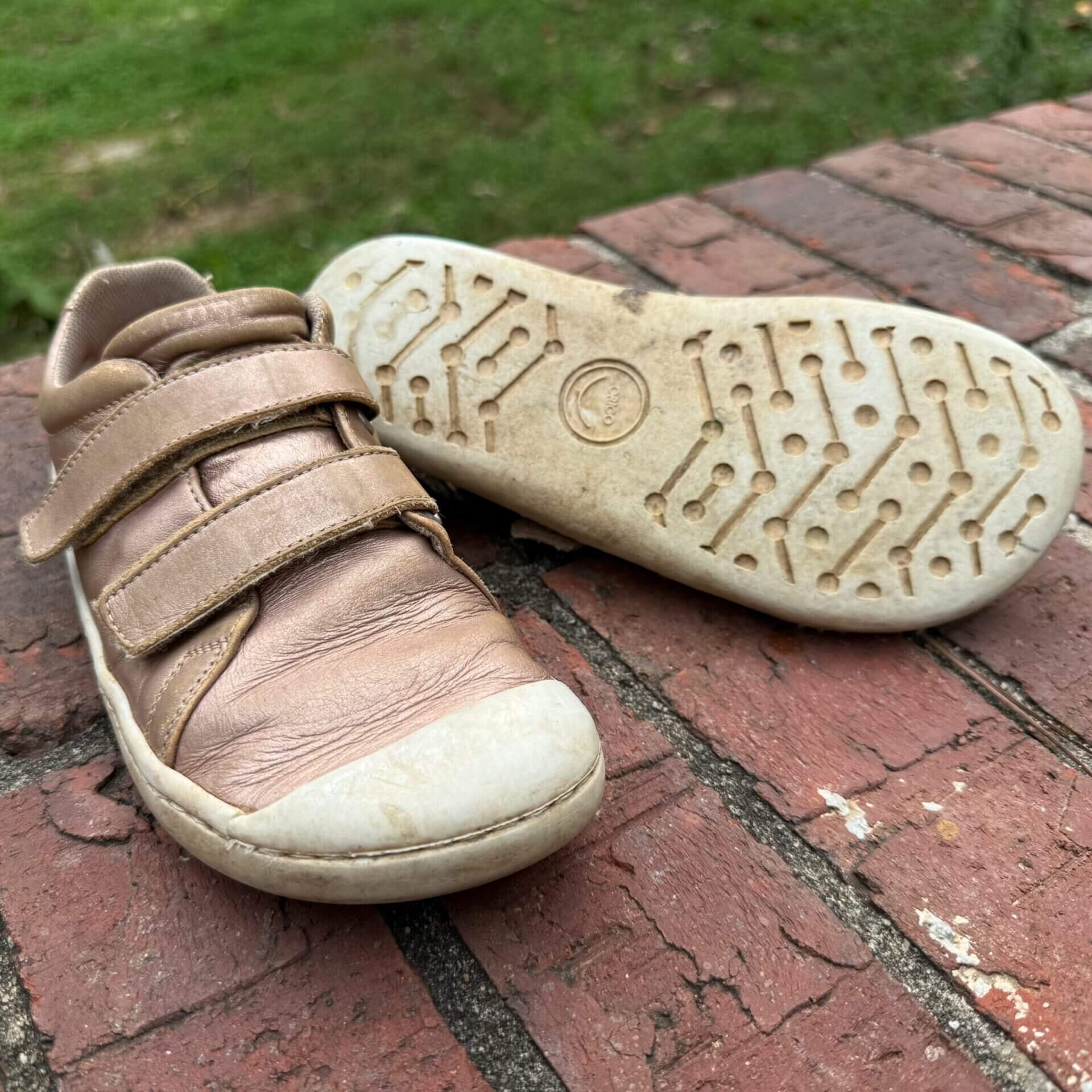
| Styles we own | Best for |
|---|---|
| The Easy Hook & Loop Leather Sneakers | Everyday use and outdoor play. |
Origo is a relatively new brand for us, but it’s quickly become one of our best overall picks for kids. Their shoes are made from sustainable, natural materials and handcrafted by artisans in Mexico, so you know you’re getting a quality product. The stack height ranges from 5 mm to 10.5 mm, which means they offer more foot protection than your typical barefoot shoes (making them ideal for kids who need a bit more cushion when playing on hard surfaces like playgrounds).
Our daughter initially hesitated about the hook-and-loop straps, but she quickly came around once she realized how easy they make it to get the shoes on and off. The wide toe box also allows for natural toe splay, which is important for her foot development. I think Origo offers great value for the price, especially considering the durability and the focus on sustainability.
For parents looking for a good, durable option for their kids’ everyday shoes, Origo is the best overall choice for natural materials and comfort. They’re not the thinnest barefoot shoes out there, but the extra protection makes them a good option for kids or anyone who needs a little more padding underfoot.
Lems
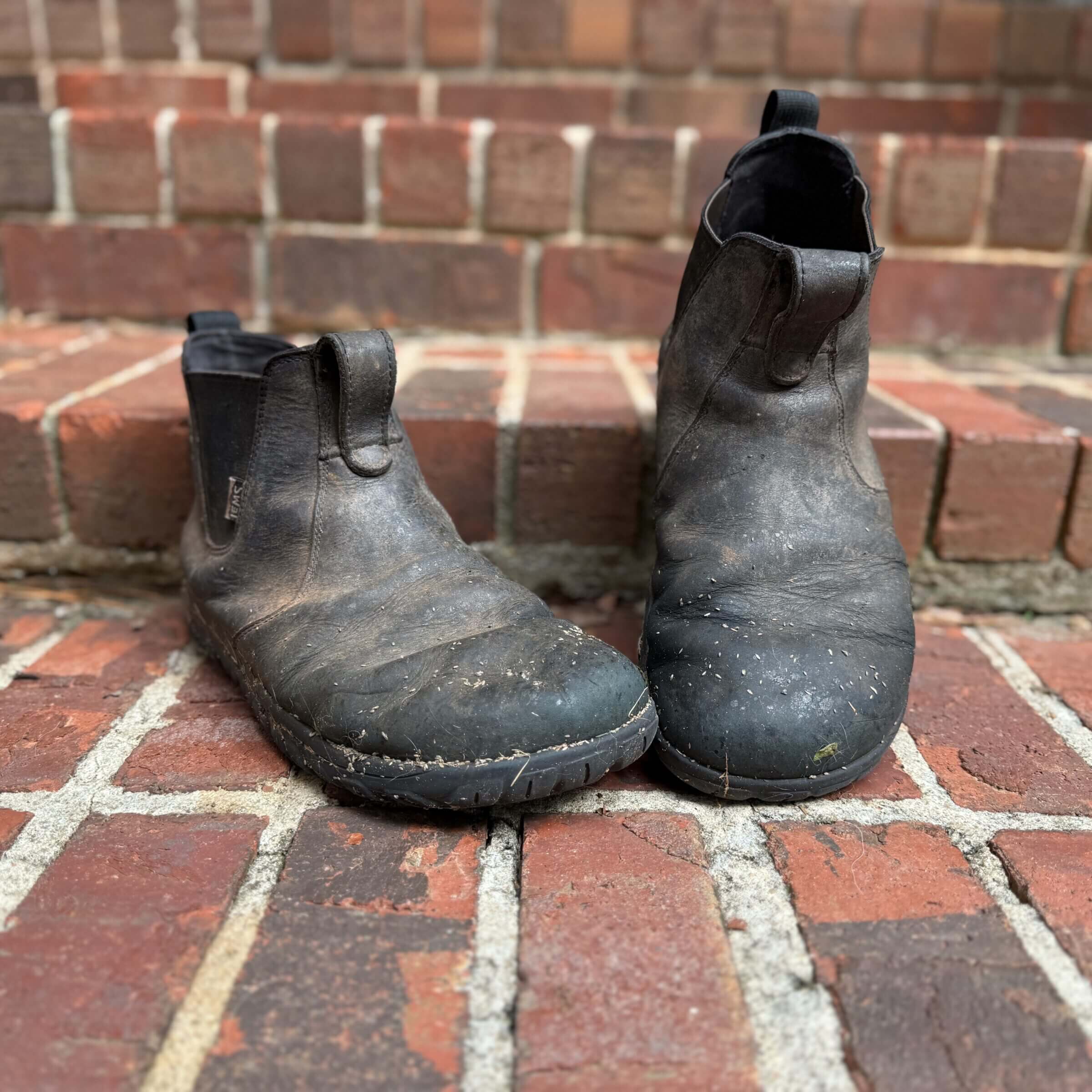
| Styles we own | Best for |
|---|---|
| Chelsea Boots | Outdoor chores (e.g., yard work). |
Lems’ Chelsea Boots have proven to be one of the best option for outdoor use, like chores on our homestead. I needed something that could handle mud, dirt and water, and Lems delivered. The 11 mm stack height is a bit thicker than most barefoot shoes, but it offers the extra foot protection I need for tough chores while still maintaining that zero-drop design for natural movement.
The full-grain oiled leather upper is another standout feature. It’s taken all the abuse I’ve thrown at it — Georgia’s red clay, rain, you name it — and the boots still look and feel great. They’re also surprisingly lightweight for a boot, which is crucial when I’m working outside all day.
At $175, the Chelsea Boot is on the pricier side, but the quality and durability you get more than make up for the cost. If you’re looking for the best for hiking, working outside, or even just running errands in a comfortable, durable barefoot boot, Lems is a fantastic choice. Plus, they’re flexible enough to wear sockless, which is perfect for warmer weather.
More Brands to Consider
Barefoot shoes have gained significant popularity over the past few years with new brands popping up on a regular basis. As a result, there are many more brands on the market I haven’t actively tested recently but that appear to be offering good-quality products. Some of the brands that are worth considering include:
- Vibram FiveFingers: Vibram FiveFingers were among the first barefoot shoes with individual toe boxes on the market. They offer excellent ground feel and flexibility, making them ideal for both outdoor and athletic activities. As I mentioned at the beginning of the article, I still own a pair of Vibrams but only use them as water shoes during beach vacations. Otherwise, I prefer the more stylish Peluvas.
- Be Lenka: Be Lenka is a European brand that makes barefoot shoes with ultra-flexible soles, focusing on both style and function. Their shoes are designed for all-day comfort and are suitable for various occasions, blending aesthetics with the benefits of barefoot footwear.
- Freet Footwear: Freet offers barefoot shoes designed for various occasions, including fitness, hiking, walking, running and everyday wear. Their shoes are made from natural materials that feature breathability and durability. They utilize unique multi-flex soles to promote natural foot movement, making them ideal for outdoor enthusiasts.
- Merrell (Vapor Glove): Merrell’s Vapor Glove line is popular for its minimalist design that provides a true barefoot feel with a thin sole and superior ground feedback. They balance barefoot benefits with a more conventional look. On a side note, I still own a pair of traditional Merrell hiking boots I purchased a decade ago.
- Wildling Shoes: Wildling offers barefoot shoes with a unique emphasis on sustainability and natural materials like wool and hemp. Their shoes are lightweight and flexible, making them ideal for natural movement while maintaining an eco-conscious approach.
If I missed any brands you like, feel free to drop them in the comments section below!
Minimalist Shoes vs. Barefoot Shoes

The terms “minimalist” and “barefoot” are sometimes used interchangeably, but there are a few important differences you should be aware of.
In a nutshell, minimalist shoes fall somewhere between traditional and barefoot shoes; they have a thinner sole than traditional shoes and offer minimal arch support and cushioning, while still encouraging a more natural foot motion compared to conventional shoes. They’re also typically more flexible than regular shoes and offer a wide toe box to allow toes to splay out naturally.
On the other hand, Barefoot shoes have a very thin sole (usually 0-4 mm thick), and no arch support or cushioning at all. They’re also very flexible and offer maximum ground feel while providing sensory feedback from the surface you walk on. You can get barefoot shoes with individual toe boxes (i.e., toe shoes) or with a wide toe box, allowing your toes to splay naturally.
Most of the shoes I cover in this article are considered barefoot shoes, while some are a hybrid of minimalist and barefoot shoes. For example, my Peluvas offer individual toe boxes and they’re incredibly flexible with zero arch support, but their outer sole is 9 mm, which is thicker than true barefoot shoes.
What to Look For When Buying Barefoot or Minimalist Shoes
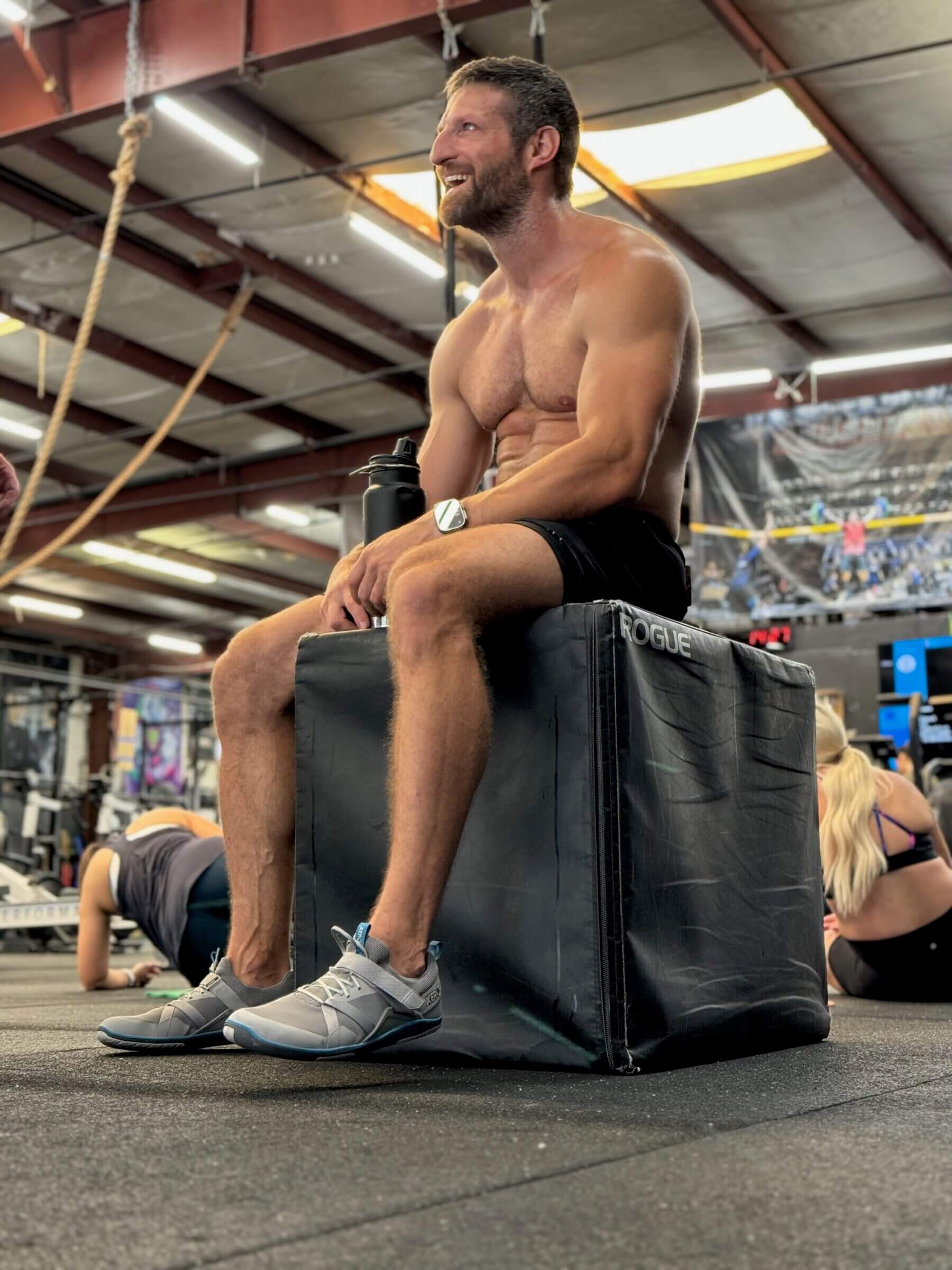
There is no one size-fits-all (literally or figuratively) when it comes to picking the right barefoot shoe for your use cases. In other words, there is no single barefoot shoe that will work well in all circumstances. However, there are certain guidelines I follow when shopping for barefoot shoes, including:
- Toe box: I opt for either individual toe boxes or a wide toe box to allow my toes to splay out naturally.
- No arch support: Supporting the arch robs your feet of the opportunity to get stronger. In other words, arch support is counter-productive to optimal foot health.
- Zero drop: Raising your heel relative to your toes is a recipe for poor posture and lower back and joint problems. I’d rather accept minimal cushioning than a pronounced heel raise.
- Sole thickness: I look for soles that are thin enough to provide proper ground contact and sensory feedback while being thick enough to remain comfortable.
- No (or minimal) cushioning: Closely related to the thickness of the sole, I stick with minimal or no cushioning.
- Flexibility: I look for shoes that bend and flex with my feet instead of preventing my feet from exploiting their full range of motion.
What to Avoid
I recommend avoiding investing in barefoot (or minimalist) shoes that carry some of the characteristics of conventional footwear, including:
- Narrow toe box: A narrow toe box prevents your toes from splaying out naturally. That can lead to misaligned toes over time, but it also negatively impacts your balance. Keep in mind that the feedback your toes provide to your brain influences foot placement and joint movement. If you impair that feedback loop, you increase your injury risk.
- Thick, stiff sole: It doesn’t matter how thin the sole is if it’s not flexible to allow for proper foot movement.
- Padding, cushioning and arch support: One of the benefits of barefoot shoes is that it helps you strengthen the muscles in your feet. Excessive padding and arch support prevent your muscles from getting stronger.
- Heavy or bulky design: If you can’t roll up the shoe into a burrito, it’s not flexible enough to support optimal foot health.
- Less than ideal fit: Make sure the shoes you pick fit well and aren’t too big or tight to avoid sliding around and getting blisters.
- Overengineered: We got a pair of Luna sandals for our 9-year-old son and they turned out to be a nightmare to take on and off because of how you had to loop the straps around your heel and through the webbing of the shoe. After a few weeks of frustration, we replaced them with Xero sandals.
- Cheap knock-offs: I dislike fast fashion with a passion and always aim to purchase high-quality footwear that will last me a long time. While that may cost a few dollars extra initially, it usually pays off over time.
As I mentioned above, no one size fits all when it comes to barefoot and minimalist shoes. So don’t be afraid to experiment and figure out what works best for you.
Final Thoughts
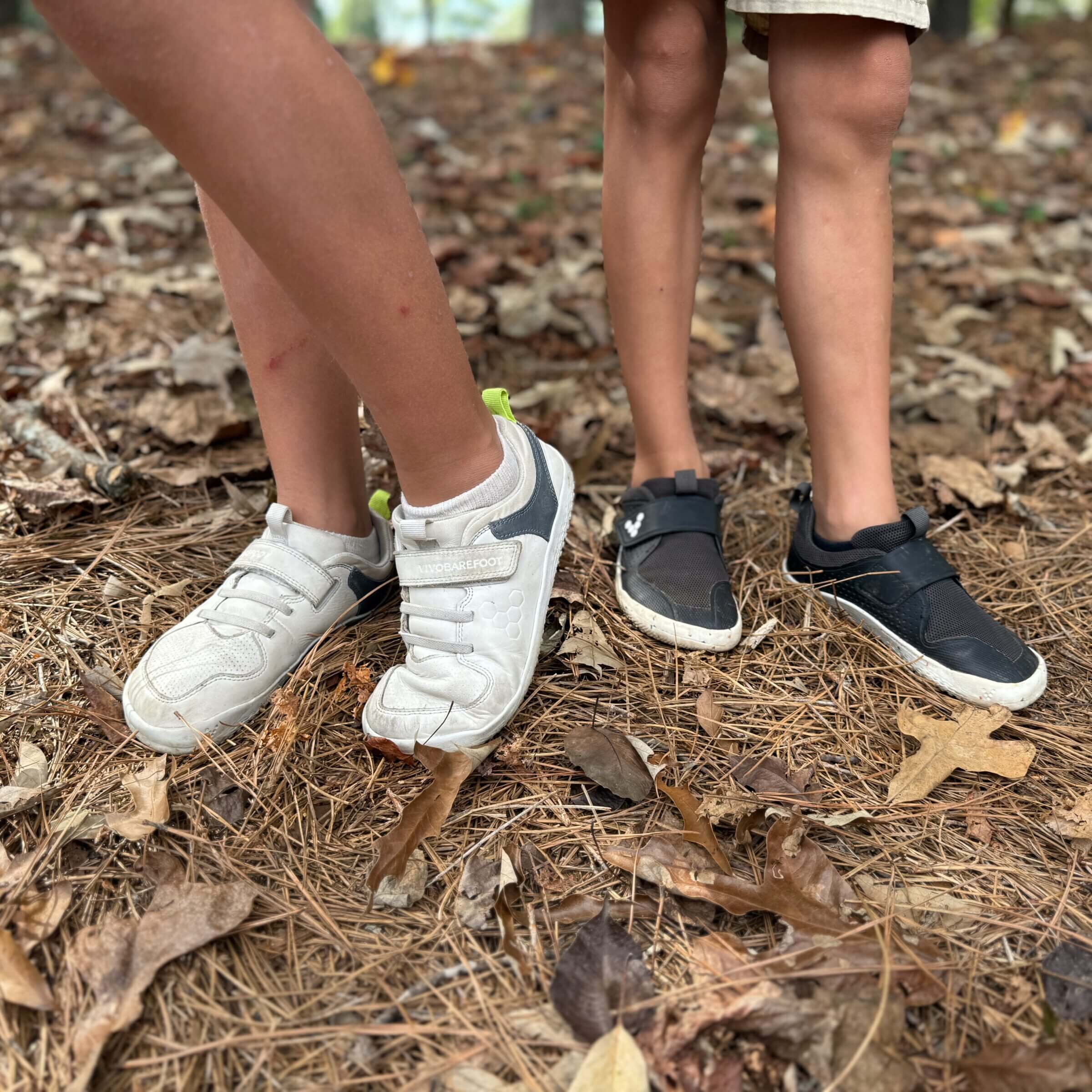
Switching to barefoot shoes has been one of the best decisions I’ve made for my health, and it’s something my entire family has embraced. From improved posture to stronger feet, the benefits are substantial. Whether you’re looking for the best for CrossFit, best for road running, or simply the best for date night, there’s a barefoot shoe out there for you.
If you end up purchasing barefoot shoes from one of the brands mentioned in this article, let me know how you like them by leaving a comment below.

Michael Kummer is a healthy living enthusiast and CrossFit athlete whose goal is to help people achieve optimal health by bridging the gap between ancestral living and the demands of modern society.


